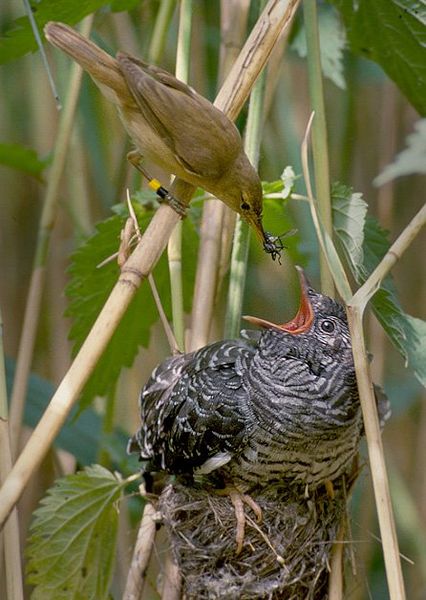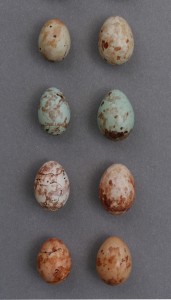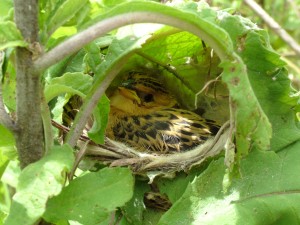Parasitic Cuckoo Finches Use an Egg Overload to Evade Host Defenses
The more eggs a parasitic cuckoo finch lays in its host’s nest, the more likely a discerning foster parent will accept the finch’s young as its own
/https://tf-cmsv2-smithsonianmag-media.s3.amazonaws.com/filer/20130924103144parasite-resized.jpg)
Few examples of parasites in nature are as infamous as the gutsy, lazy cuckoo bird, which lays its eggs in unsuspecting nests so it doesn’t have to bother with rearing its own young. The garish cuckoo chick, oftentimes dwarfing its host parents in size, monopolizes food by mimicking its siblings cheeps but screaming the loudest, and by thrusting its gaping beak out whenever “mom” or “dad” show up with a tasty morsel. The monster chick will oftentimes go so far as to kick its step-siblings out of the nest, issuing a death sentence by starvation, predation or the elements.

An infamously manipulative common cuckoo chick gobbling down snacks from its reed warbler foster parent. Photo by Per Harald Olsen
But those cuckolded host parents aren’t completely dim. They are engaged in a constant evolutionary sprint with these enemy brood parasites and are continuously adapting new ways to weed out the impostors and confirm their own eggs’ identity. They mentally imprint on their own eggs, for example, and repeatedly scan their nest in a game of which-of-these-things-does-not-belong. If they spot an egg that does not fit their internal template, they throw it overboard.
They also examine their nest to determine proportions of different egg types, favoring the majority since common cuckoos only lay one egg per nest. If there’s three brown eggs and one speckled one, they will surmise that the speckled one must contain an unwanted baby bomb.
One brood parasite, the the diminutive cuckoo finch, uses many of the same strategies, although it belongs to a different biological order of birds than the common cuckoo. Unlike its larger cousins, however, the clever cuckoo finch has developed a novel method for outsmarting those discerning hosts, according to researchers from the University of Cambridge and the University of Cape Town in a new paper published in Nature Communications.
“Interactions between hosts and parasites are often evolutionarily older in the tropics than in the better-studied temperate parts of the world, resulting in sophisticated trickery and counter-defense such as this,” said Claire Spottiswoode, a zoologist at the University of Cambridge and co-author of the paper, in an email.
Rather than simply match her eggs to her victim’s own colors and patterns, the mother cuckoo finch plants a minefield of parasitism, laying several eggs at once to ensure the balance is tipped in her manipulative favor.
“Brood parasites and their hosts are often locked in an ongoing arms race of attack and defense, with each escalating over evolution,” explained Martin Stevens<, an ecologist at the University of Exeter (formerly of the University of Cambridge) and lead author of the paper, in an email. “Our work shows that cuckoo finches have a cunning strategy to beat host defenses and trick them into accepting not just one, but often multiple parasitic eggs.”

Prinia eggs on the left are matched with mimetic cuckoo finch eggs on the right. Photo by Claire Spottiswoode
To arrive at these findings, Stevens, Spottiswoode and co-author Jolyon Troscianko traveled to Zambia. They searched the grasslands for nests built by tawny flanked prinias, a somewhat drab passerine bird that is a favorite victim of cuckoo finches. The prinias lay a lovely array of colored eggs–red, blue, olive and white, of all different speckled patterns–although females stick to one egg color and pattern type throughout their life times.
Rather than mimic those eggs, cuckoo finches rely upon chance luck to get their egg-matching right. ”Adult cuckoo finches and prinia might not be the most exciting birds to look at in terms of their plumage, but when you see how wonderfully colorful and diverse their eggs are, you realize that there must be a remarkable evolutionary battle going on inside the host nests,” Stevens says.
To figure out how the cuckoos manage their deceit, the researchers performed several field experiments. First, they swapped prinia eggs in different configurations between around 50 nests. Some birds received one foreign egg and kept two of their own, while others received one egg and kept three, or two eggs and kept two.
The team recorded how often the birds purged their nests of suspect eggs; which of those eggs they kicked out; and how close a visual match those foreign eggs were compared to their own. They found that the prinias were significantly more likely to reject the foreign eggs than their own eggs. In the few cases that they rejected their own eggs, the foreign eggs were a very close match in color and pattern.
By further statistically analyzing these results, the team was able to break down which factors influence whether or not a host bird rejects or accepts an egg. They found that pattern diversity, pattern size and the proportion of foreign eggs all significantly influenced whether a host bird keeps or dumps a foreign egg.
The more impostor eggs that pop up in a nest, however, the more extreme the color differences need to be for the host bird to pick up on the trick, the researchers found. They ran a model of known cuckoo egg patterns and ratios compared to prinias, and found that cuckoos will randomly closely match egg color and pattern with the prinias about 25 percent of the time.
These predictions were reflected in the real-life nest dramas at play on the savannah. Of 62 prinia nests that cuckoo finches had parasitized, the researchers found that two-thirds contained two or three cuckoo eggs laid by the same female. Tellingly, in just over half of those nests only cuckoo eggs remained, indicating that the host parents likely unknowingly expelled their own unborn chicks.
“By laying several eggs in a host nest, the cuckoo finch causes confusion in host defenses, and when this is combined with effective mimicry, the parasite can outwit the host and help more of its young to be reared,” Stevens says.
Unlike common cuckoos, cuckoo finch chicks don’t actively kill their nest mates, alleviating the possibility that parasitic chicks will engage in a gladiator-like battle for survival against their true brothers and sisters. To confirm this, the researchers kept an eye on around a dozen parasitized nests, watching what happened as the chicks grew older. In 85 percent of those dysfunctional families, two parasitic chicks fledged from a single nest. Avoiding murderous impulses is likely yet another clever adaptation the species has pursued for perfecting its multi-egg laying regime, the team writes, since those chirping nest-mates are more likely than not to be parasitic siblings.
“Tropical species surely still have many more intriguing adaptations yet to reveal to us,” Spottiswoode said. “One of the many reasons we’re lucky to work in Zambia is not only its wonderful study species, but also the help of our brilliant team of local assistants who have found every single nest involved in our field experiments over the last seven years.”
/https://tf-cmsv2-smithsonianmag-media.s3.amazonaws.com/accounts/headshot/Rachel-Nuwer-240.jpg)

/https://tf-cmsv2-smithsonianmag-media.s3.amazonaws.com/accounts/headshot/Rachel-Nuwer-240.jpg)